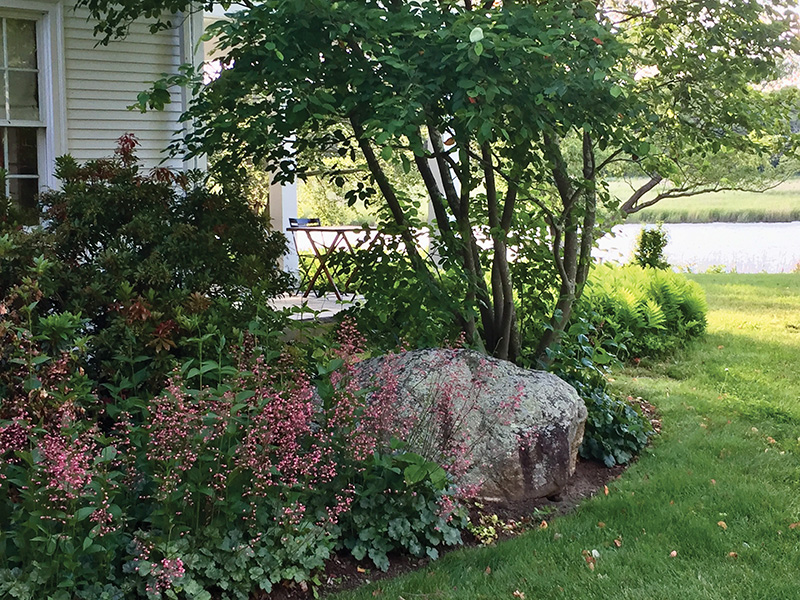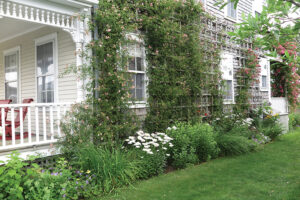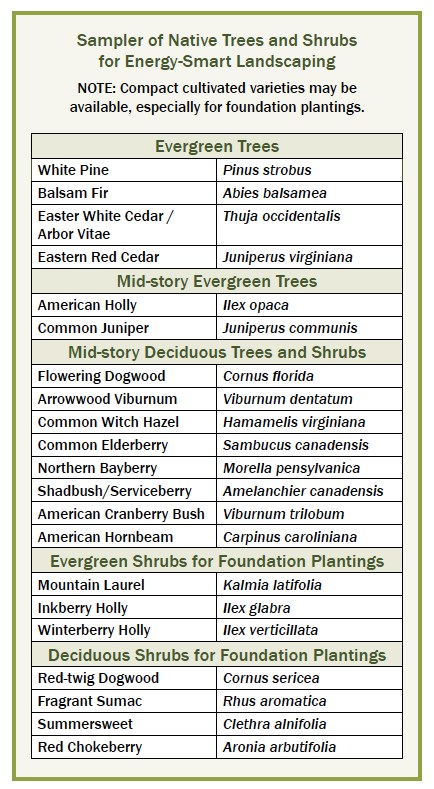

An attractive foundation planting at the Florence Griswold Museum in Old Lyme provides insulation,
and the shadbush (Amelanchier canadensis) offers shade without being a threat to the building.

An attractive foundation planting at the Florence Griswold Museum in Old Lyme provides insulation,
and the shadbush (Amelanchier canadensis) offers shade without being a threat to the building.
Energy Smart Landscaping:
Your Yard Can Save You Money While Helping to Save the Planet
Is Your Landscape Helping?
Winter is a good season to take a closer look at the “bones” of your home landscape, with an eye toward planning something new or editing what you have. Look for bald spots, a view you’d like to plug, or how to reduce all that demanding lawn.
This is also a great time to consider how your landscape can help you with your seasonal energy bills. According to Cornell University, well-planned landscaping for energy efficiency can reduce heating and cooling costs by 10 to 30 percent.
Computer modeling done by the US Department of Energy has shown that just three well placed trees can save the average household cooling and heating costs. And shading your window air conditioner in the summer can reduce your electricity use by as much as 10% (provided your air intake is not obstructed).
Your home landscape can lower your energy bills while enhancing your yard, all the while reducing the demand for fossil fuels (as well as the climate-impacts of extracting, processing, and transporting it). Energy efficient landscaping is a win-win consideration for you and the planet.
Put Evergreens to Work
Windbreaks, also called a shelterbelt, have been employed on farms and ranches for years to protect soil, crops, and livestock. In very exposed and storm-prone locations, evergreen trees are the real work-horses of the home landscape, effective at deflecting and reducing cold winds, as well as controlling snowdrift.
A solid row of evergreens next to a wall or fence can create dead-air space for year-round insulation. In the estuary region, the dense and dark foliage of our native cone-bearing conifers—pine, fir, juniper, and cedar—are the backbone of an effective windbreak.
Location is essential. A wind break of trees should be placed at right angles to the prevailing wind and be longer than the area to be protected, although just a few well-placed trees can make a difference. The best wind protection occurs when the windbreak is no more than one or two tree heights from the house.
Perhaps counterintuitively, the most effective windbreak is not necessarily a solid one; the objective is not to push the wind over the top, but to slow it down going through. Planting at an optical density—the proportion of the view that is filled with leaves, branches, and trunks—of about 65 percent is best.
For a more attractive windbreak that is also valuable to wildlife, consider adding depth—up to three rows of staggered species and heights, with at least one row of dense evergreens surrounded by mixed evergreen and deciduous shrubs.

In addition to foundation plantings, climbing plants and vines can also provide modest insulation—and beauty, to a home.
Foundation Planting for Insulation
Shrubs along your home’s foundation don’t need to be massive to add insulation benefits. Evergreen shrubs will add contrast and winter interest, although planting too close together and too close to the foundation can cause issues with mold or mildew. A mix of evergreen and deciduous shrubs with a two to three-foot distance from the house when mature will ensure air circulation as well as access to windows, hose outlets and general home maintenance.
If some of your existing foundation plants are showing signs of decline, consider interplanting new, more desirable species, allowing the newer plants to become established without creating a gap. Although uncultivated, or “straight,” native plant species are preferable for their ecological benefits, there are many compact cultivated varieties of native shrubs that make them especially suitable as foundation plantings.
Summer Shading
It makes sense that deciduous trees, planted on the south and west sides of your home, will keep your house cooler in the summer while letting the sun provide passive heat as it comes through the leafless branches in winter.
Increasing concern about damage from falling limbs has unfortunately resulted in preemptive tree cutting, especially along the coast. Although a well-maintained, mature tree can be an asset to any home, the alternative is to work with some of our native mid-story trees—such as shadbush (serviceberry)—placed at a distance from the house to allow its mature canopy to still provide shade without posing a damage risk.
Landscaping can help curb air, water, and soil pollution. Through the natural process of photosynthesis, trees and shrubs absorb carbon dioxide and other pollutant particulates, then store the carbon and emit pure oxygen. Well-placed plants not only soften our home energy costs, but they cool paved surfaces, reduce evaporation of hydrocarbon emissions from parked vehicles, and reduce the temperature of stormwater into our waterways where it can impact aquatic plants and animals. Energy-smart plantings protect the well-being of humans and collectively contribute to a more livable planet.
Judy Preston is a local ecologist active in the Connecticut River Estuary.
